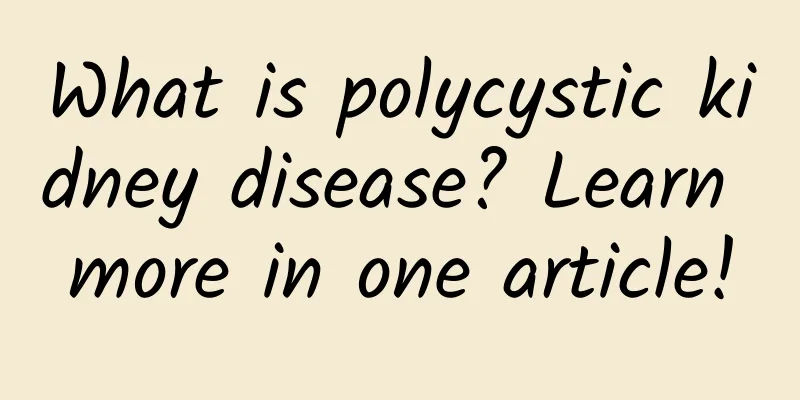What is polycystic kidney disease? Learn more in one article!

|
Polycystic kidney disease is a genetic disease. How is it inherited? Polycystic kidney disease follows the law of autosomal dominant inheritance, with equal incidence in males and females. If one of the parents is sick, 50% of the children will inherit the cyst gene and become ill. If both the father and the mother are sick, the incidence of the children increases to 75%. Children who are not sick do not carry the cyst gene. If they marry someone of the opposite sex who does not have polycystic kidney disease, their children will not become ill, and the disease will not be inherited from the next generation. It is extremely rare for a person to be infected by a gene mutation instead of being inherited from the parents. What are the symptoms of polycystic kidney disease? Is it serious when it starts? There are basically no symptoms in the early stages of polycystic kidney disease, so many patients are not diagnosed with polycystic kidney disease. Common initial symptoms of polycystic kidney disease include high blood pressure, hematuria, and abdominal pain. Sometimes the initial symptoms may be urinary tract infection or kidney stones. The development of any disease has a process of priority, and polycystic kidney disease is no exception. In particular, the kidney's compensatory function is very strong. When it is initially disturbed by external factors such as cysts or some inflammation, the clinical manifestations are often not obvious, and daily life, work and study are all normal. What is the process of polycystic kidney disease developing into uremia? Polycystic kidney disease is a condition in which the entire kidney is covered with cysts of various sizes. These cysts will grow larger with age, which will compress the kidney, damage the kidney structure, and reduce the number of kidney units that produce urine. Later, the kidney is damaged to the point where it cannot sustain normal human life, and uremia will occur at this time. To be precise, the formation process of renal failure and uremia is actually the gradual fibrosis of the kidney. Moreover, renal failure and uremia are functional manifestations that only appear after renal fibrosis reaches 50%. What role does blocking renal fibrosis play in the treatment of the disease? Effectively stopping the process of renal fibrosis is an important way to control the deterioration of the disease. Blocking renal fibrosis means reversing the damaged renal intrinsic cells, restoring renal function, and eliminating the pathogenic factors. Blocking renal fibrosis in the treatment of polycystic kidney disease is achieved by: (1) shrinking the cysts and reducing the pressure of the cysts on the surrounding tissues; (2) restoring the function of the injured tissues, thereby minimizing kidney damage and maximizing the recovery of function. Controlling the development of cysts may avoid or delay the occurrence of renal insufficiency or uremia. Renal cyst expert tips Timing of treatment The earlier polycystic kidney disease is treated, the better the effect. The best time to use effective treatment methods is when there is no renal damage. This is a period that polycystic kidney disease patients must remember. If the development of cysts is controlled at an early stage, it is possible to avoid or delay the occurrence of renal insufficiency or uremia. Drug treatment Currently, there are three drugs that have been proven to inhibit cyst growth and protect kidney function: rapamycin, somatostatin, and vasopressin receptor antagonists. However, somatostatin is an intravenous injection, which is extremely inconvenient to use; vasopressin antagonists are not yet available in China; and rapamycin is mainly used in transplant departments, is expensive, and is not easy to purchase. Surgery Surgical treatment of polycystic kidney disease, especially decompression surgery, was once the first choice of treatment. Later observations showed that this operation would accelerate the process of renal fibrosis and lead to faster loss of renal function. However, for larger cysts and those with more obvious clinical compression symptoms, surgical treatment can also be adopted, but remember that it is only applicable to larger cysts. |
<<: Eating too many oranges may turn you into a "Minion"
Recommend
What are the harms of abortion to the human body?
Abortion is an abnormal situation and is also a m...
Will vaginitis affect pregnancy?
Vaginitis is an extremely harmful disease symptom...
How to have a good confinement period
When you are in confinement after childbirth, the...
Will boys be annoyed when girls keep sending messages? What are the techniques to guide boys to take the initiative to chat?
In the process of dating, boys and girls are a ve...
What does a dead hairy crab look like? How to tell if a hairy crab is dead or alive?
Hairy crabs have a lot of meat, are delicious, ca...
There is a hard lump on the vulva that does not hurt or itch
Gynecological diseases are relatively common dise...
What porridge does my aunt drink?
A woman's period is very, very important beca...
Symptoms of improvement of fungal vaginitis
In modern life, women's gynecological disease...
What are the symptoms of women before menopause
A woman's menopause is a prerequisite for ent...
What is the cause of the coffee-colored vaginal discharge?
Some female friends have brown, paste-like vagina...
Skin allergies? What allergies?
This is the 3613th article of Da Yi Xiao Hu "...
What causes breast pain after menstruation
Menstruation is one of the physiological characte...
Which countries are in the European Cup? When does the European Cup start?
The European Cup is a top-level national football...









